Find Out the Degree of Pronation of Your Child – These Shoes Can Significantly Realign Your Child’s Feet!

I want to start by telling parents that pronation in children is normal. We all have a certain degree of pronation, the issue arises when that pronation becomes excessive, usually referred to as overpronation. Usually, when children experience overpronation their foot muscles are shifted in an inefficient position and that’s when we would get concerned about it. I am going to show you how to find out the degree of pronation of your child by following two simple steps. We will be looking at real-life examples (images and videos).
Keep in mind that there are 3 different degrees of pronation:
- Mild
- Moderate
- Strong
The degree of each child’s pronation determines whether parents need to seek early intervention or not. By intervention, I mean providing children with a pair of supportive shoes, orthotics, or both.
Find Out the Degree of Your Child’s Pronation
I will need three images of your child’s feet as shown below. Make sure that the images are taken on a flat surface. It’s hard to tell whether a child is flat-footed or not when the images are taken on the carpet. Below you can find a sample of how the images should look like:
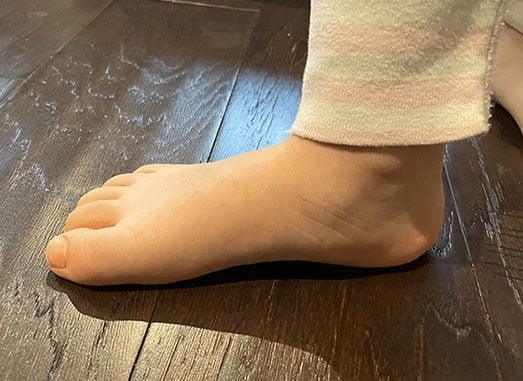
This image helps determine whether your child is flat footed and whether your child has a high instep or not.

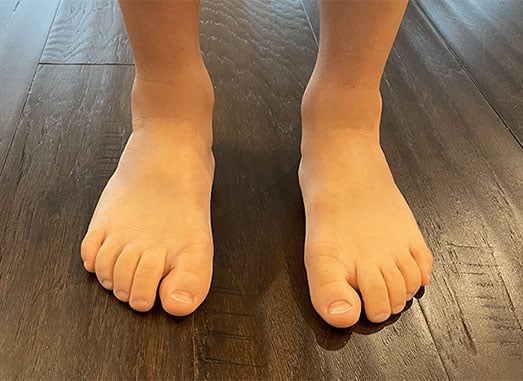
This image helps determine whether your child has narrow, medium, wide, or extra wide feet.
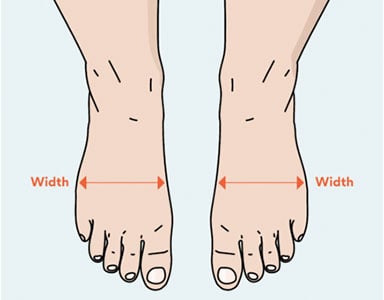
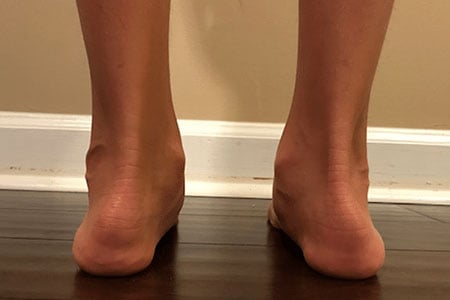
This image helps determine whether your child has rolled ankles or not.
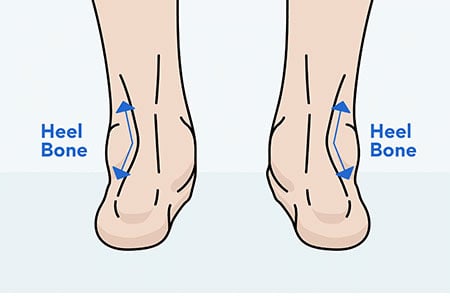
Where Should You Send the Images?
Once you have the images ready you will need to send them to my email address:
fittingchildrensshoes@gmail.com
Feel free to add any additional images or videos, as the more information you send me, the more informative decision I can make.
Mild Pronation Examples — Before and After Images
Let’s start by taking a look at an image of a child with mild pronation standing barefoot. In this particular case, we can see that the child’s feet are tilting inwards.
Before Image
This is an image of a child with mild pronation standing barefoot:
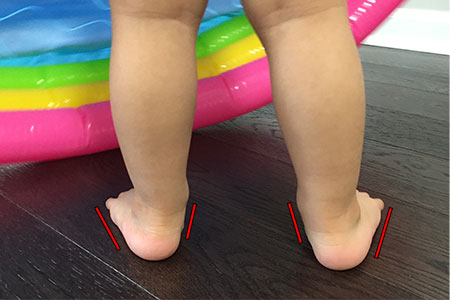
After Image
Let’s see what happens when we fit that same child in a pair of supportive shoes. Do you notice how the child’s feet are a lot straighter? These are not orthopedic shoes, just everyday sneakers that provide targeted support to key areas of the foot. Your child’s muscles continue to do all the work even when wearing supportive shoes.
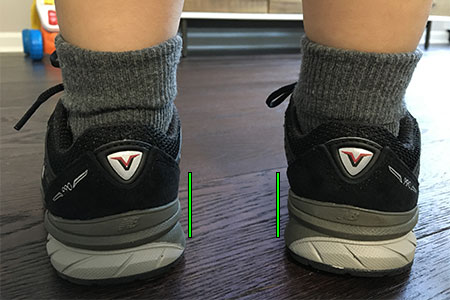
Mild pronation is very common and parents should not worry too much as long as the child doesn’t complain about foot or leg pain. It is quite normal for a toddler or young child (ages 1-6) to stand and walk with pronated feet. However, if you notice that your child’s walking gait is abnormal and your child takes clumsy steps, you can provide your child with a pair of supportive shoes to allow your child to walk and run straighter.
Moderate Pronation Examples — Before and After Images
Let’s take a look at a child with moderate pronation standing barefoot. In this case, we can see how the child is flat-footed and there is clear ankle rolling on the left foot. Children who experience moderate pronation show clear signs of poor walking habits as the feet turn inwards at a considerable level.
Before Image
This is an image of a child with moderate pronation standing barefoot:

After Image
For cases of moderate pronation supportive shoes are recommended. The shoes in the image below are everyday sneakers that simply provide better support than others. Do you notice how the child’s feet are a lot straighter? Notice how the left foot which was collapsing the most is a lot straighter now.

Strong Pronation Examples — Before and After Images
Let’s take a look at a child with strong pronation standing barefoot. In this specific case, we can see how the right ankle is rolling inwards excessively. That inward ankle roll can cause knees, hips, and back to shift out of alignment. If left untreated, expect pain in all three areas.
Before Image
This is an image of a child with strong pronation standing barefoot:
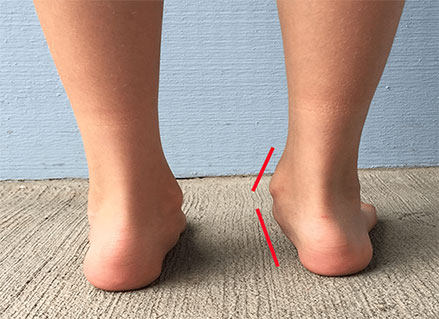
After Image
Let’s take a look at an image of the same child wearing a pair of supportive shoes I recommend. The shoes are making a tremendous difference in preventing the child’s right ankle from collapsing and turning inwards. Keep in mind that the child is not wearing an orthotic inside the shoes, but in most cases of strong pronation the child might need an orthotic to help prevent the feet from collapsing and rolling inwards.
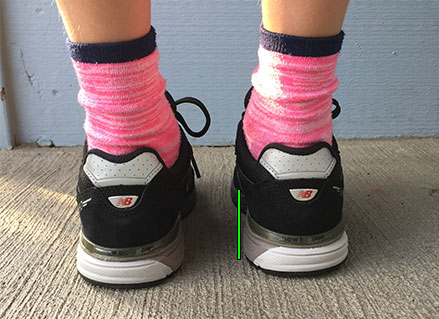
For cases of strong pronation the shoes and the orthotics need to provide stability and prevent the foot/ankle to slide into that excessive position.
It’s important to clarify that in all of the examples above the child is wearing supportive shoes that still allow the muscles to continue to do all the work.
Be Proactive and Don’t Take the “Wait and See Approach”
If your child has moderate or strong pronation can shift your child’s body out of alignment and affect your child’s walking gait and overall posture. Once the feet are pronated, your child’s knees and hips also become misaligned. This means that the muscles that move those joints no longer work efficiently, and it will take more energy for your child to do the same work as other children who don’t have this condition.
Pronation can leave your child exhausted. Your child’s muscles have to work harder due to the body’s poor positioning. This may be why your child is more inclined to sit rather than run and play.
How to Effectively Treat Your Child’s Pronation
Some parents tell me they have their children walk barefooted to “strengthen” their feet and ankles. In my experience, prolonged barefoot walking on an overpronated foot may at times exaggerate the deformity.
It’s clear that the correct type of shoes can make a world of difference when it comes to treating your child’s pronation.
I have put together a selection of the most effective shoes for children with pronation. These shoes work best for children with moderate and strong pronation, but can be worn by children with mild pronation as well. It’s important to note that these shoes provide excellent support but your child’s muscles continue to do all the work.
Best Shoes for Kids with Pronation – Realign Your Child’s Feet
Keep in mind that these shoes are available in different widths such as medium (M), wide (W), and extra wide (XW), so make sure that you choose your child’s foot width accordingly. Disclosure: Some links in this post may be affiliate links and we may receive a small commission (at no extra cost to you) when you click our links and make purchases.
Most pediatricians and physical therapists advise parents that their child’s foot condition will resolve on its own. However, taking the “wait and see approach” can only lead to your child’s condition getting worse. The earlier you intervene, the better. Remember that by intervention I am just advising parents to provide their children with the correct type of shoes and depending on whether the child is experiencing foot or leg pain, orthotics as well.
The shoes I recommended will help realign your child’s feet, which will help secure a stronger foundation for your child’s body, facilitating better muscle functioning and strength, improving balance and coordination, and preventing present and future pathology.
Should You Provide Your Child with a Pair of Orthotics?
If you believe that your child can benefit from wearing an orthotic as well, I suggest that you take a look at the article on the best orthotics for pronation.
Parents are usually pretty good at noticing when something is wrong with their children. I get contacted by parents from all over the world who are worried about their child’s foot posture and walking gait. Whichever approach you decide to take, remember that the correct type of shoes can make a world of difference when it comes to treating your child’s pronation.
Find Out the Degree of Pronation of Your Child – Watch Video
In this video, I will help guide you through simple steps to assess the degree of pronation in your child’s feet. You will learn how to observe your child’s feet from different angles to assess the arch and alignment.
Early identification of excessive pronation can help you take proactive steps to support your child’s foot health, including selecting appropriate footwear or consulting with a healthcare professional if needed.
If you need any further guidance or clarification you can leave me a message in the comments section below.


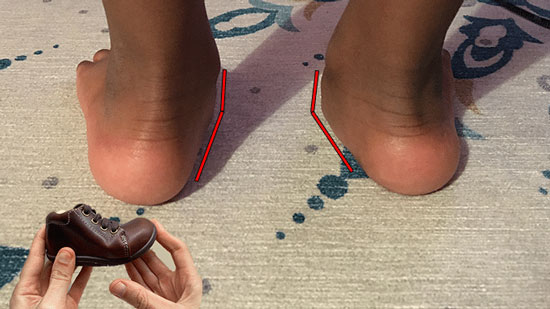
Hello Juan,
This is an EXCELLENT website. I have a question: do you offer recommendations on “house shoes” for children; something easy to slip on and off, while offering some support. We purchased a pair of recommended NB shoes for my son (shoe size 5, moderate pronation), however I need something to keep him from being barefoot in the house. What would you recommend? Many thanks!
Hello Alexa,
I am glad you find the website informative.
To recommend specific house shoes for your son I first need to know his foot shape (narrow, medium, wide, extra wide), whether he wears a toddler or a big kid shoe size 5, and the country that you are contacting me from to check what specific shoes you might be able to order.